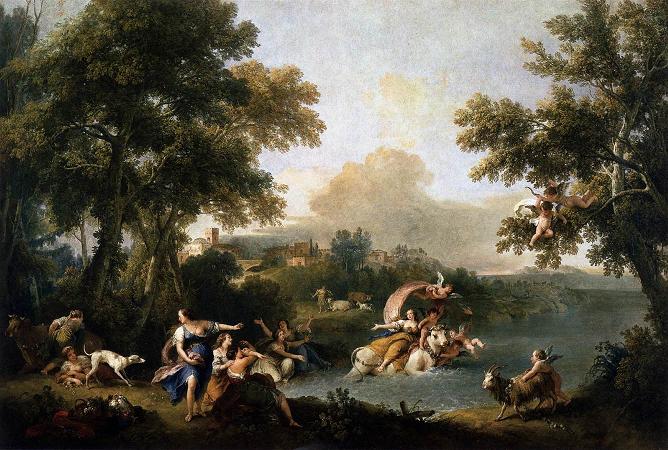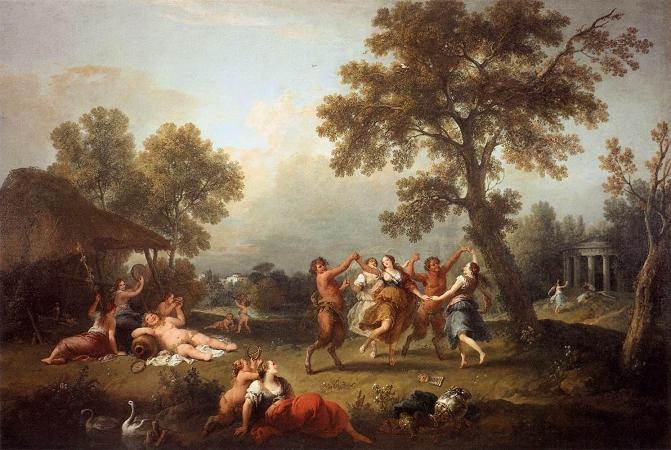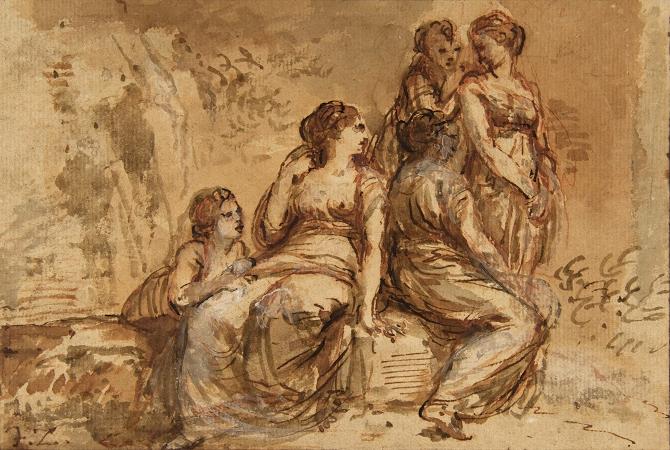Francesco Zuccarelli (1702 - 1788). Giacomo Francesco Zuccarelli was an Italian artist of the late Baroque or Rococo period. He is considered to be the most important landscape painter to have emerged from his adopted city of Venice during the mid-eighteenth century, and his Arcadian views became popular throughout Europe and especially in England where he resided for two extended periods. His patronage extended to the nobility, and he often collaborated with other artists such as Antonio Visentini and Bernardo Bellotto. In 1768, Zuccarelli became a founding member of the Royal Academy of Arts, and upon his final return to Italy, he was elected president of the Venetian Academy. In addition to his rural landscapes which frequently incorporated religious and classical themes, Zuccarelli created devotional pieces and on occasion did portraiture. Beside paintings, his varied output included etchings, drawings, and designs for tapestries as well as a set of Old Testament playing cards. Despite the fame he experienced in his lifetime, Zuccarelli's reputation declined in the early 19th century with naturalism becoming increasingly favoured in landscapes. Turner criticized him in mild terms while confessing that his figures could be beautiful, paving the way for more severe Victorian assessments. In 1959, the art historian Michael Levey offered suggestions for why Zuccarelli held such wide contemporary appeal among the English, concluding that his best work is highly decorative. More recently, since the 1990s there has been a renewed focus on Zuccarelli among Italian scholars, who have given him prominence in several books and articles, and his paintings and drawings are regularly shown in exhibitions. The third-youngest of four sons, Giacomo Francesco Zuccarelli was born at Pitigliano, in southern Tuscany, on 15 August 1702. His prosperous father Bartolomeo owned several local vineyards, and also in the northwest not far from Pisa, a shop offering kitchen tools and spices. Around the age of eleven or twelve, Francesco began his apprenticeship in Rome with the portrait painters Giovanni Maria Morandi and his pupil Pietro Nelli, under whose tutelage he learned the elements of design while absorbing the lessons of Roman classicism. Zuccarelli completed his first commission in his hometown of Pitigliano in the years 1725-27, a pair of chapel altarpieces. With the sponsorship of the Florentine art connoisseur, Francesco Maria Niccolo Gabburri, from 1728 to 1731 he devoted his energies mostly to etching, eventually producing at least 43 prints, the majority consisting of two series which recorded the deteriorating frescoes of Giovanni da San Giovanni and Andrea del Sarto. During his five years spent in Florence, though preoccupied with figurative subjects, he began to experiment with drawings in landscape, as shown by works now preserved in the department of prints and drawings at the Uffizi, including a view of the Tuscan capital. According to Luigi Lanzi, writing in the 1790s, the Roman landscape painter and etcher Paolo Anesi was the key mentor of Zuccarelli in the genre which eventually led to his renown. In 1732, after a stay of several months in Bologna, Francesco relocated to Venice. Prior to his arrival in the Republic, the death of Marco Ricci in 1730 had created an opening in the field of landscape painting amid a marketplace crowded with history painters. While continuing to paint religious and mythological works, he increasingly devoted his attention to landscapes, drawing inspiration from the classicism of Claude and the Roman school. His early paintings from the 1730s show briefly the influence of Alessandro Magnasco, and for a longer period, of Ricci. Zuccarelli brought a more mellow and airy palette to the typically Venetian colors, and using tonal values of higher luminous content than Ricci, the figures in his idyllic landscapes came to life. An almost immediate success in Venice, he enjoyed early patronage, from amongst others, Marshal Schulenburg; Joseph Smith, who became his longtime patron; and Francesco Algarotti; who recommended him to the Elector of Saxony, Augustus III of Poland. In 1735, Francesco married Giustina Agata Simonetti in the church of Santa Maria Zobenigo in Venice, and they had four daughters, the first two dying as infants, followed by two sons. He attended the baptism of the daughter of the painter Gaspare Diziani in 1743, and he often worked with other artists, including Bernardo Bellotto and Antonio Visentini. Under the auspices of Consul Smith, during the mid 1740s he produced with Visentini a series featuring neo-Palladian architecture, as can be seen in Burlington House.
more...














